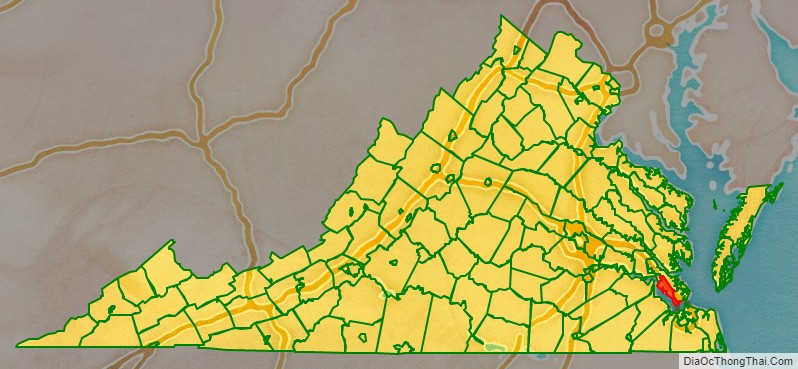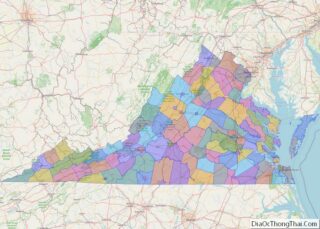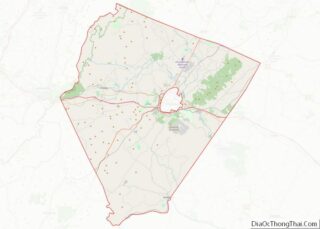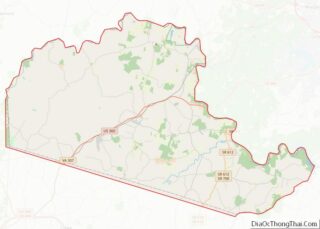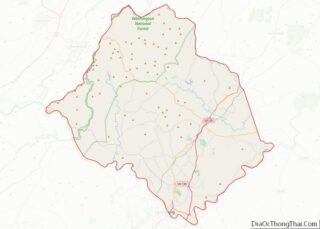Newport News (/ˌnuːpɔːrt -, -pərt -/) is an independent city in the U.S. state of Virginia. At the 2020 census, the population was 186,247. Located in the Hampton Roads region, it is the 5th most populous city in Virginia and 140th most populous city in the United States.
Newport News is included in the Hampton Roads metropolitan area. It is at the southeastern end of the Virginia Peninsula, on the northern shore of the James River extending southeast from Skiffe’s Creek along many miles of waterfront to the river’s mouth at Newport News Point on the harbor of Hampton Roads. The area now known as Newport News was once a part of Warwick County. Warwick County was one of the eight original shires of Virginia, formed by the House of Burgesses in the British Colony of Virginia by order of King Charles I in 1634.
In 1881, fifteen years of rapid development began under the leadership of Collis P. Huntington, whose new Peninsula Extension of the Chesapeake and Ohio Railway from Richmond opened up means of transportation along the Peninsula and provided a new pathway for the railroad to bring West Virginia bituminous coal to port for coastal shipping and worldwide export. With the new railroad came a terminal and coal piers where the colliers were loaded. Within a few years, Huntington and his associates also built a large shipyard. In 1896, the new incorporated town of Newport News, which had briefly replaced Denbigh as the seat of Warwick County, had a population of 9,000. In 1958, by mutual consent by referendum, Newport News was consolidated with the former Warwick County (itself a separate city from 1952 to 1958), rejoining the two localities to approximately their pre-1896 geographic size. The more widely known name of Newport News was selected as they formed what was then Virginia’s third largest independent city in population.
With many residents employed at the expansive Newport News Shipbuilding, the joint U.S. Air Force–Army installation at Joint Base Langley–Eustis, and other military bases and suppliers, the city’s economy is very connected to the military. The location on the harbor and along the James River facilitates a large boating industry which can take advantage of its many miles of waterfront. Newport News also serves as a junction between the rails and the sea with the Newport News Marine Terminals located at the East End of the city. Served by major east–west Interstate Highway 64, it is linked to other cities of Hampton Roads by the circumferential Hampton Roads Beltway, which crosses the harbor on two bridge-tunnels. Part of the Newport News/Williamsburg International Airport is in the city limits.
| Name: | Newport News City |
|---|---|
| FIPS code: | 51-700 |
| State: | Virginia |
| Land Area: | 68.99 sq mi (178.68 km²) |
| Population Density: | 2,699.62/sq mi (1,042.33/km²) |
Newport News City location map. Where is Newport News City?
History
European settlement
During the 17th century, shortly after founding of Jamestown, Virginia, in 1607, English settlers explored and began settling the areas adjacent to Hampton Roads. In 1610, Sir Thomas Gates “took possession” of a nearby Native American village, which became known as Kecoughtan. At that time, settlers began clearing land along the James River (the navigable part of which was called Hampton Roads) for plantations, including the present area of Newport News.
In 1619, the area of Newport News was included in one of four huge corporations of the Virginia Company of London. It became known as Elizabeth Cittie and extended west all the way to Skiffe’s Creek (currently the border between Newport News and James City County). Elizabeth Cittie included all of present-day South Hampton Roads.
By 1634, the English colony of Virginia consisted of a population of approximately 5,000 inhabitants. It was divided into eight shires of Virginia, which were renamed as counties shortly thereafter. The area of Newport News became part of Warwick River Shire, which became Warwick County in 1637. By 1810, the county seat was at Denbigh. For a short time in the mid-19th century, the county seat was moved to Newport News.
Restoration
Newport News was a rural area of plantations and a small fishing village until after the American Civil War. Construction of the railroad and establishment of the great shipyard brought thousands of workers and associated development. It was one of only a few cities in Virginia to be newly established without earlier incorporation as a town. (Virginia has had an independent city political subdivision since 1871.) Walter A. Post served as the city’s first mayor.
The area that formed the present-day southern end of Newport News had long been established as an unincorporated town. During Reconstruction, the period after the American Civil War, the new City of Newport News was essentially founded by California merchant Collis P. Huntington. Huntington, one of the Big Four associated with the Central Pacific Railroad, in California, formed the western part of the country’s First transcontinental railroad. He was recruited by former Confederate General Williams Carter Wickham to become a major investor and guiding light for a southern railroad. He helped complete the Chesapeake and Ohio Railway to the Ohio River in 1873. On October 19, 1881, the first train to ever depart from Newport News left Lee Hall Depot on temporary tracks, and arrived at Yorktown for the ‘Cornwallis Surrender Centennial Celebration”, a commemoration of the British defeat at the Battle of Yorktown.
Huntington knew the railroad could transport coal eastbound from West Virginia’s untapped natural resources. His agents began acquiring land in Warwick County in 1865. In the 1880s, he oversaw extension of the C&O’s new Peninsula Subdivision, which extended from the Church Hill Tunnel in Richmond southeast down the peninsula through Williamsburg to Newport News, where the company developed coal piers on the harbor of Hampton Roads.
His next project was to develop Newport News Shipbuilding and Drydock Company, which became the world’s largest shipyard. Opened as Chesapeake Dry Dock & Construction Company, the shipbuilding was intended to build boats to transition goods from the rails to the seas. With president Theodore Roosevelt’s declaration to create a Great White Fleet, the company entered the warship business by building seven of the first sixteen warships.
1900s
In addition to Collis, other members of the Huntington family played major roles in Newport News. From 1912 to 1914, his nephew, Henry E. Huntington, assumed leadership of the shipyard. Huntington Park, developed after World War I near the northern terminus of the James River Bridge, is named for him.
Collis Huntington’s son, Archer M. Huntington and his wife, sculptor Anna Hyatt Huntington, developed the Mariners’ Museum beginning in 1932. They created a natural park and the community’s Mariners’ Lake in the process. A major feature of Newport News, the Mariners’ Museum has grown to become one of the largest and finest maritime museums in the world.
The city grew in territory through the annexation of parts of Warwick County and also of the town of Kecoughtan in adjoining Elizabeth City County.
In 1958, the citizenry of the cities of Warwick and Newport News voted by referendum to consolidate the two cities, choosing to assume the better-known name of Newport News. The merger created the third largest city by population in Virginia, with a 65 square miles (168 km) area. The boundaries of the City of Newport News today are essentially the boundaries of the original Warwick River Shire and the traditional one of Warwick County, with the exception of minor border adjustments with neighbors.
The city’s original downtown area, on the James River waterfront, changed rapidly from a farm trading town to a new city in the last quarter of the 19th century. Development of the railroad terminal, with its coal piers, other harbor-related facilities, and the shipyard, brought new jobs and workers to the area. Although fashionable housing and businesses developed in downtown, the increase in industry and the development of new suburbs pushed and pulled retail and residential development to the west and north after World War II. Such suburban development was aided by national subsidization of highway construction and was part of a national trend to newer housing.
In July 1989, the United States Navy commissioned the third naval vessel named after the city with the entry of the Los Angeles-class nuclear submarine USS Newport News, built at Newport News Shipbuilding, into active service.
The ship was initially commanded by CDR. Mark B. Keef; the city held a public celebration of the event, which was attended by Vice President of the United States Dan Quayle. In conjunction with this milestone, a song was written by a city native and formally adopted by Newport News City Council in July 1989. The lyrics appear with permission from the author:
2000s
Despite city efforts at large-scale revitalization, by the beginning of the 21st century the downtown area consisted largely of the coal export facilities, the shipyard, and municipal offices. It is bordered by some harbor-related smaller businesses and lower income housing.
Newport News grew in population from the 1960s through the 1990s. The city began to explore New Urbanism as a way to develop areas midtown. City Center at Oyster Point was developed out of a small portion of the Oyster Point Business Park. It opened in phases from 2003 through 2005. The city invested $82 million of public funding in the project. Closely following Oyster Point, Port Warwick opened as an urban residential community in the new midtown business district. Fifteen hundred people now reside in the Port Warwick area. It includes a 3-acre (1.2 ha) city square where festivals and events take place.
In January 2023, a six-year-old shot his teacher Abby Zwerner in an elementary school in Newport News, VA.
Newport News City Road Map
Geography
Newport News is located at 37°4′15″N 76°29′4″W / 37.07083°N 76.48444°W / 37.07083; -76.48444 (37.071046, −76.484557). According to the United States Census Bureau, the city has a total area of 120 square miles (310 km), of which 69 square miles (180 km) is land and 51 square miles (130 km) (42.4%) is water.
The city is located at the Peninsula side of Hampton Roads in the Tidewater region of Virginia, bordering the Atlantic Ocean. The Hampton Roads Metropolitan Statistical Area (officially known as the Virginia Beach-Norfolk-Newport News, VA-NC MSA) is the 37th largest in the nation with a 2014 population estimate of 1,716,624. The area includes the Virginia cities of Norfolk, Virginia Beach, Chesapeake, Hampton, Newport News, Poquoson, Portsmouth, Suffolk, Williamsburg, and the counties of Gloucester, Isle of Wight, James City, Mathews, Surry, and York, as well as the North Carolina counties of Currituck and Gates. Newport News serves as one of the business centers on the Peninsula. The city of Norfolk is recognized as the central business district, while the Virginia Beach oceanside resort district and Williamsburg are primarily centers of tourism.
Newport News shares land borders with James City County on the northwest, York County on the north and northeast, and Hampton on the east. Newport News shares water borders with Portsmouth on the southeast and Suffolk on the south across the Hampton Roads Area, and Isle of Wight County on the southwest and west and Surry County on the northwest across the James River.
Cityscape
The city’s downtown area was part of the earliest developed area which was initially incorporated as an independent city in 1896. The earlier city portions also included the “East End” or “Southeast” community, which was predominantly African-American, the “North End” and the shipyard and coal piers. The town of Kecoughtan in Elizabeth City County was annexed by Newport News in 1927, extending the city along Hampton Roads from Salter’s Creek to Pear Avenue. After World War II, public housing projects and lower income housing were built to improve housing in what came to be known as the East End or “The Bottom” by locals. The city expanded primarily westward where land was available and highways were built. While the shipyard and coal facilities, and other smaller harbor-oriented businesses have remained vibrant, the downtown area went into substantial decline. Crime problems have plagued the nearby lower-income residential areas.
West of the traditional downtown area, another early portion of the city was developed as Huntington Heights. In modern times been called the North End. Developed primarily between 1900 and 1935, North End features a wealth of architectural styles and eclectic vernacular building designs. Extending along west to the James River Bridge approaches, it includes scenic views of the river. A well-preserved community, the North End is an historic district listed on the National Register of Historic Places and the Virginia Landmarks Register.
The 1958 merger by mutual agreement with the City of Warwick removed the political boundary, which was adjacent to Mercury Boulevard. This major north–south roadway carries U.S. Route 258 between the James River Bridge and the Coliseum-Central area of adjacent Hampton. At the time, the county was mostly rural, although along Warwick Boulevard north of the Mercury Boulevard, Hilton Village was developed during World War I as a planned community. Beyond this point to the west, much of the city takes on a suburban nature. Many neighborhoods have been developed, some around a number of former small towns. Miles of waterfront along the James River, and tributaries such as Deep Creek and Lucas Creek, are occupied by higher-end single family homes. In many sections, wooded land and farms gave way to subdivisions. Even at the northwestern reaches, furthest from the traditional downtown area, some residential development has occurred. Much land has been set aside for natural protection, with recreational and historical considerations. Along with some newer residential areas, major features of the northwestern end include the reservoirs of the Newport News Water System (which include much of the Warwick River), the expansive Newport News Park, a number of public schools, and the military installations of Fort Eustis and a small portion of the Naval Weapons Station Yorktown.
At the extreme northwestern edge adjacent to Skiffe’s Creek and the border with James City County is the Lee Hall community, which retains historical features including the former Chesapeake and Ohio Railway station which served tens of thousands of soldiers based at what became nearby Fort Eustis during World War I and World War II. The larger-than-normal rural two-story frame depot is highly valued by rail fans and rail preservationists.
In downtown Newport News, the Victory Arch, built to commemorate the Great War, sits on the downtown waterfront. The “Eternal Flame” under the arch was cast by Womack Foundry, Inc. in the 1960s. It was hand crafted by the Foundry’s founder and president, Ernest D. Womack. The downtown area has a number of landmarks and architecturally interesting buildings, which for some time were mostly abandoned in favor of building new areas in the northwest areas of the city (a strategy aided by tax incentives in the postwar years).
City leaders are working to bring new life into this area, by renovating and building new homes and attracting businesses. The completion of Interstate 664 restored the area to access and through traffic which had been largely rerouted with the completion of the Hampton Roads Bridge-Tunnel connecting neighboring Hampton with the Southside in 1958 and discontinuance of the Newport News-Norfolk ferry service at that time. The larger capacity Monitor-Merrimac Memorial Bridge-Tunnel and the rebuilt James River Bridge each restored some accessibility and through traffic to the downtown area.
Much of the newer commercial development has been along the Warwick Boulevard and Jefferson Avenue corridors, with newer planned industrial, commercial, and mixed development such as Oyster Point, Kiln Creek and the City Center. While the downtown area had long been the area of the city that offered the traditional urban layout, the city has supported a number of New Urbanism projects. One is Port Warwick, named after the fictional city in William Styron’s novel, Lie Down in Darkness. Port Warwick includes housing for a broad variety of citizens, from retired persons to off-campus housing for Christopher Newport University students. Also included are several high-end restaurants and upscale shopping.
City Center at Oyster Point, located near Port Warwick, has been touted as the new “downtown” because of its new geographic centrality on the Virginia Peninsula, its proximity to the retail/business nucleus of the city, etc. Locally, it is often called simply “City Center”. Nearby, the Virginia Living Museum recently completed a $22.6 million expansion plan.
Newport News is also home to a small Korean ethnic enclave on Warwick Boulevard near the Denbigh neighborhood on the northern end of the city. Although it lacks the density and character of larger, more established enclaves, it has been referred to as “Little Seoul”—being the commercial center for the Hampton Roads Korean community.
Neighborhoods
Newport News has many distinctive communities and neighborhoods within its boundaries, including Brandon Heights, Brentwood, City Center, Colony Pines, Christopher Shores-Stuart Gardens, Denbigh, Glendale, East End, Hidenwood, Hilton Village, Hunter’s Glenn, Beaconsdale, Ivy Farms, North End Huntington Heights (Historic District – roughly from 50th to 75th street, along the James River), Jefferson Avenue Park, Kiln Creek, Lee Hall, Menchville, Maxwell Gardens, Morrison (also known as Herpesville and Gum Grove), Newmarket Village, Newsome Park, Oyster Point, Parkview, old North Newport News (Center Ave. area), Port Warwick, Richneck, Riverside, Shore Park, Summerlake, Village Green, Windsor Great Park and Warwick. Some of these neighborhoods are located in the former City of Warwick and Warwick County.
Climate
Newport News is located in the humid subtropical climate zone, with cool to mild winters, and hot, humid summers. Due to the inland location, throughout the year, highs are 2 to 3 °F (1.1 to 1.7 °C) warmer and lows 1 to 2 °F (0.6 to 1.1 °C) cooler than areas to the southeast. Snowfall averages 5.8 inches (15 cm) per season, and the summer months tend to be slightly wetter. The geographic location of the city, with respect to the principal storm tracks, favours fair weather, as it is south of the average path of storms originating in the higher latitudes, and north of the usual tracks of hurricanes and other major tropical storms.

